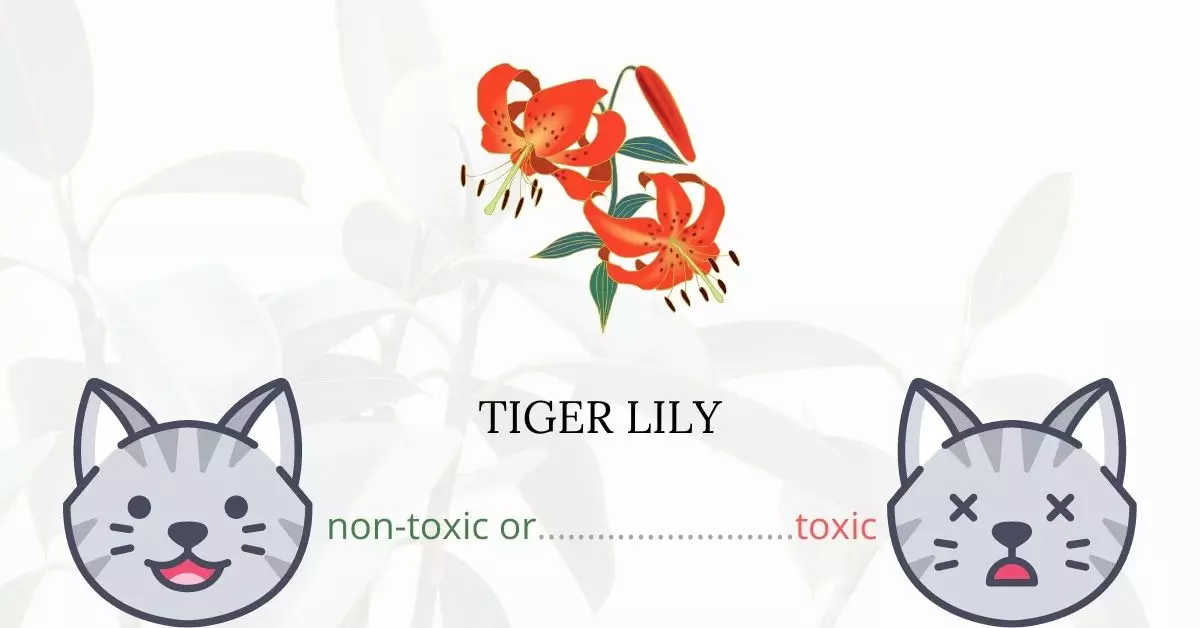Tiger Lilies, scientifically recognized as part of the Lilium and Hemerocallis species, are unequivocally toxic to cats, posing serious risks to their kidney functions. Every part of the tiger lily plant, including petals, leaves, stems, and pollen, is laden with toxins. Ingesting even a minimal amount or mere exposure to its pollen can trigger severe allergic reactions and other substantial health issues in cats. While the specific toxin in lilies responsible for causing harm is not precisely identified, the repercussions of exposure are notably detrimental.
This article is crafted in collaboration with a panel of seasoned Doctors of Veterinary Medicine (DVMs), who have bestowed their extensive knowledge and insights to ensure the provision of accurate and current information regarding the potential hazards of various plants, in this instance, Tiger Lilies, to cats. Their invaluable contributions allow a deeper exploration into the adverse effects of these plants on feline companions. Additionally, thorough research has been undertaken utilizing high-authority websites such as ASPCA and PetMD to corroborate every piece of information and provide a comprehensive view on the subject at hand. Through meticulous research and expert insights, this article aims to shed light on the imperative subject of plant toxicity in cats, enabling cat owners to foster a safer environment for their pets.
Clinical Signs of Tiger Lily Poisoning in Cats

When cats come into contact with, ingest, or even inhale pollen from Tiger Lily plants, they may exhibit a series of clinical signs indicative of poisoning, generally surfacing within 6-12 hours post-exposure. If these symptoms are left unattended, they may escalate to severe renal failure, potentially proving fatal. Here we delve into each clinical sign, its underlying cause, and the ensuing effects owing to exposure to Tiger Lily.
- Vomiting: Typically one of the initial signs, it occurs due to the body’s attempt to expel the ingested toxins, reflecting the immediate adverse impact of the Tiger Lily components on the cat’s system.
- Loss of Appetite: Affected cats may exhibit an aversion to food as the toxins disrupt normal digestive processes, inducing a state of nausea and digestive discomfort.
- Lethargy: The presence of toxins in the system can result in overall weakness and reduced energy levels as the body struggles to combat the adverse effects.
- Dehydration: Resulting from vomiting and a potential lack of fluid intake due to loss of appetite, dehydration can exacerbate the overall condition of the affected feline.
- Excessive Thirst or Lack of Thirst: The toxins can disrupt the normal functioning of the kidneys, leading to imbalances in fluid regulation and subsequent alterations in thirst perception.
- Excessive Urination or Lack of Urination: As renal function is compromised, the ability to produce urine may be affected, leading to either increased frequency of urination or a complete inability to urinate.
- Disorientation: Neurological disruptions caused by the toxins may lead to confusion and a lack of coordinated movements in cats.
- Inability to Walk: Severe toxicity may impact the neurological system, causing muscle weakness and impairing the cat’s ability to walk.
- Seizures: The severe impact on the neurological system can induce seizures, representing advanced stages of toxicity.
- Ulcerated Gums: The ingested toxins can cause damage to the mucous membranes, leading to the formation of painful ulcers in the gums.
- Tremors: Muscular tremors may manifest as the toxins affect neuromuscular functions, reflecting heightened levels of distress in the cat’s system.
- Renal Failure: When left untreated, the accumulation of toxins can lead to irreversible damage to the kidneys, culminating in renal failure.
Each of these signs underscores the urgent need for immediate veterinary attention to counteract the effects of the toxins and to initiate supportive care to mitigate further damage to the cat’s system. It is pivotal to be vigilant and seek prompt medical intervention to safeguard the health and well-being of the feline companions.
First Aid and Treatment of Tiger Lily Poisoning in Cats

The sooner your cat can get to the veterinary clinic to get the poisoning symptoms under control, the better. The veterinarian will most likely force your cat to vomit in most cases. Your veterinarian may then administer activated charcoal to your cat through a tube. Activated charcoal absorbs a variety of toxins, allowing them to safely travel through your cat’s digestive tract. Your cat’s vital signs and organ function will be monitored on a regular basis.
Supportive treatment, such as intravenous fluids and oral drugs, is usually given for 2-3 days to help avoid kidney damage from the toxin. Kidney failure in cats usually needs hospitalization and careful therapy. After a diagnosis of renal failure, dialysis should be explored as soon as possible.
Recovery from Tiger Lily Poisoning in Cats

When treated with dialysis, around 50% of cats will survive renal failure, however, it may take 3-4 weeks for the kidneys to regain enough function to be able to stop dialysis. Many of the cats that survive will regain complete renal function, but some may continue to have chronic kidney impairment.
Prevention of Tiger Lily Poisoning in Cats
To avoid lily toxicity, you should never bring a lily into a home with cats. Limit your cat’s access to the outdoors to avoid exposure to lilies and other harmful plants in your neighborhood.
If you love plants but have cats at home, check out these lists:





